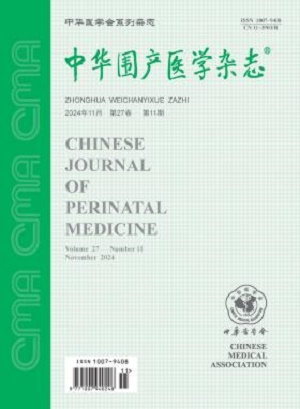胎儿完全性肺静脉异常连接的产前超声特征
Q4 Medicine
引用次数: 0
摘要
目的探讨胎儿全肺静脉连接异常(TAPVC)的产前超声特征。方法选取2013年6月至2018年6月在郑州大学第三附属医院接受产前超声检查并经产后手术诊断为TAPVC的41例患者。回顾性分析所有病例的超声心动图表现,总结产前影像学特征。结果术后确诊心上型21例,心内型14例,心下型4例,混合型2例。TAPVC超声心动图表现如下:41例患者均可见左心房后壁光滑,四房面未见部分肺静脉与左心房相连;33例左心房与降主动脉间隙加宽,四房位见肺静脉汇合处;四室位冠状窦扩张10例,上腹部位三支血管及气管垂直静脉27例。41例患者均未并发其他结构性心内异常。7例合并血流阻塞,多普勒超声测得血流速度为0.76 ~ 1.25 m/s。结论产前超声检查应仔细观察肺静脉血流情况,当肺静脉与左心房不相通时应考虑肺静脉连接异常。关键词:肺静脉;先天性异常;弯刀综合症;超声,产前本文章由计算机程序翻译,如有差异,请以英文原文为准。
Prenatal ultrasonographic features of fetal total anomalous pulmonary venous connection
Objective
To investigate the prenatal ultrasonographic features of fetal total anomalous pulmonary venous connection (TAPVC).
Methods
Forty-one cases who received prenatal ultrasound examination and then were diagnosed with TAPVC by postnatal surgery at the Third Affiliated Hospital of Zhengzhou University from June 2013 to June 2018 were enrolled. Echocardiography findings of all cases were analyzed retrospectively, and the prenatal imaging features were summarized.
Results
Among all cases, 21 were confirmed as supracardiac type, 14 as intracardiac type, four as infracardiac type and two as mixed type after surgery. The echocardiographic features of TAPVC were as follows: all 41 cases showed smooth posterior wall of left atrium without visible part of pulmonary venous connected to the left atrium in the-four chamber view; in 33 cases, the space between left atrium and descending aorta was widened and the pulmonary venous confluence was observed in the four-chamber view; ten cases showed a dilated coronary sinus in the four-chamber view and 27 cases showed vertical vein in the three vessels and trachea or the upper abdomen view. None of the 41 cases was complicated by other structural intracardiac abnormalities. However, seven cases were complicated by obstruction of blood flow, and the blood flow velocity measured by Doppler ultrasound was 0.76 m/s to 1.25 m/s.
Conclusions
Blood flow in pulmonary veins should be carefully observed in prenatal ultrasonography, and anomalous pulmonary venous connection should be considered when pulmonary veins do not connect to the left atrium.
Key words:
Pulmonary veins; Congenital abnormalities; Scimitar syndrome; Ultrasonography, prenatal
求助全文
通过发布文献求助,成功后即可免费获取论文全文。
去求助
来源期刊

中华围产医学杂志
Medicine-Obstetrics and Gynecology
CiteScore
0.70
自引率
0.00%
发文量
4446
期刊介绍:
Chinese Journal of Perinatal Medicine was founded in May 1998. It is one of the journals of the Chinese Medical Association, which is supervised by the China Association for Science and Technology, sponsored by the Chinese Medical Association, and hosted by Peking University First Hospital. Perinatal medicine is a new discipline jointly studied by obstetrics and neonatology. The purpose of this journal is to "prenatal and postnatal care, improve the quality of the newborn population, and ensure the safety and health of mothers and infants". It reflects the new theories, new technologies, and new progress in perinatal medicine in related disciplines such as basic, clinical and preventive medicine, genetics, and sociology. It aims to provide a window and platform for academic exchanges, information transmission, and understanding of the development trends of domestic and foreign perinatal medicine for the majority of perinatal medicine workers in my country.
 求助内容:
求助内容: 应助结果提醒方式:
应助结果提醒方式:


